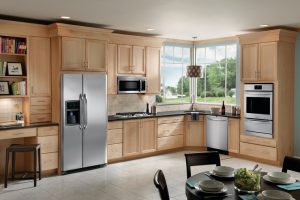Keep Your Doors Closed
Regardless of your refrigerator model, the cheapest and easiest way to reduce its energy usage is to keep the doors closed. Standing in front of your open fridge will allow cold air to escape, resulting in more energy being needed to return it to the correct temperature. If possible, try to decide what you need before you open up your refrigerator or freezer. This will limit the times you open it each day, resulting in significant energy savings.
Replace Your Rubber Door Seal
This seemingly unimportant lining is often overlooked and is actually critical to the efficient operation of your refrigerator. This door seal or gasket prevents unwanted warmer air entering your refrigerator, but it can wear over time. When the gasket becomes worn, it loses suction and will weaken, forcing your appliance to work harder to maintain a cool temperature.
Move Your Refrigerator From Heat Sources
Your refrigerator compressor kicks into high gear to keep your food at the perfect temperature. Unfortunately, when your refrigerator is near a source of heat, it will kick in more frequently, wasting energy and causing your appliance to work harder and harder. When designing your kitchen, keep your refrigerator away from your oven, range, dishwasher and any other sources emitting high levels of heat. Ideally, your refrigerator should also be out of prolonged periods of direct sunlight.
Clean Your Condenser Coils
Refrigerator condenser coils remove warmth from your appliance, but unfortunately, their location at the underside or back of your refrigerator means that they can collect dust. This debris makes it difficult for the coils to operate efficiently, forcing increased energy usage. Cleaning your coils is a relatively simple task that should be tackled at least a couple of times each year, and you should find the instructions in your owner’s manual.
Cool Your Leftovers
Even seemingly minor details can help reduce your energy bills and allowing your leftovers time to cool is just one example. This will reduce the heat added to inside your refrigerator, just don’t allow your food to sit out for too long or you risk spoiling. Ensure that your leftovers are properly stored in Tupperware or covered in protective wrap to prevent any residual heat from escaping inside your refrigerator.
Clear the Clutter
Organizing the interior of your refrigerator and freezer can not only keep things neat, it can reduce your energy bill. When things are easier to find, you’ll spend less time opening up the door, reducing your energy usage. You should also use the top shelf for your most used items. This is prime real estate, where items are easier to reach allowing the door to be closed quickly. So, move large things such as serving dishes, food boxes, etc off the top shelf. These larger items can also trap heat inside the refrigerator, forcing the appliance to work harder, so keep them near the bottom of the refrigerator.
Check Your Refrigerator Temperature
Finally, be sure to check your refrigerator temperature. There is no need for it to be set at freezing cold temperatures as this will use more energy and could even cause damage to delicate food items. The optimum temperature for a refrigerator is 36 to 38ºF, while your freezer should be 0 to 5ºF.
If you have concerns that your refrigerator is using a great deal of energy, it is worth calling in a home appliance repair specialist. A professional repair technician can check your appliance for any underlying issues to ensure that it is operating at peak efficiency.
